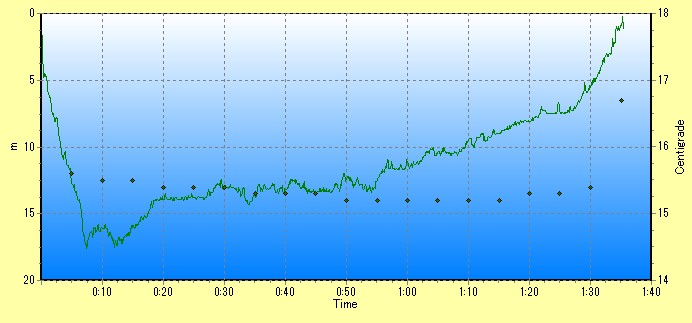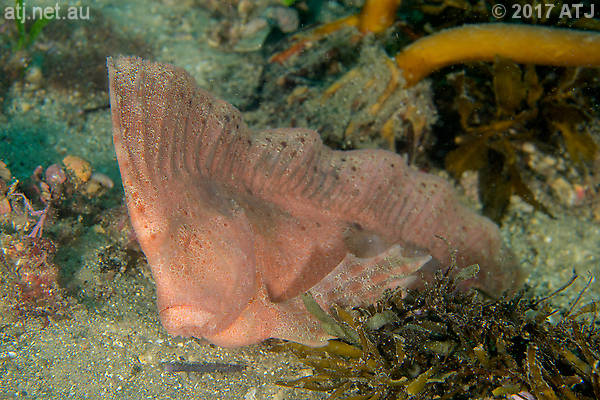Dive Details
Location
Date
Friday 17 November 2017
Time
9:51am - 11:26am
Details
With a moderate to large ENE swell hitting Sydney, Bare Island was the best place to dive, especially considering the outgoing tide which would have generated a strong current at The Monument (like 2 weeks ago). Bare Island is well protected even from easterly swells so we were able to get in on the western side of the island.
We got in from the shelf on the western side of the island just to the south of the north-west point. We surface swam out before descending. The surface water was not very clear but conditions improved as we descended below 5 metres. Visibility was up to 10 metres. It was quiet cold though with the temperature dropping to almost 15°C (compared with 18°C on Monday). I was sort of glad that I'd broken the zip in my westuit and was in a drysuit. We swam at around 240° until we reached the end o the deep wall. We turned right and followed the wall until it ended.
We swam past the area where the seahorses had been (2 years ago) and followed the reef along until we hit the gap. We then headed north. Before we reached the sand we found some Cratena lineata and Flabellina rubrolineata nudibranchs and an umbrella snail.
We crossed the sand and hit the next reef and then turned left to head around the island. I was looking intently for pygmy pipehorses. George spotted a tiny red-lined bubble shell and while he was photographing I spotted a slightly larger one.
We turned north as we headed around the point and swam to the area in front of the caves. I was still looking for pygmies but found none. I had a really good look on New Pygmy Rock but couldn't find a single one. I even looked carefully on the rock where the two white ones had been for some time last year but didn't see one. (I found one there the next day so I must have overlooked her.)
I started to look for the male great seahorse and scoured the area where I have previously seen him. There was a lot of kelp around so he could have been in that and not very visible. I found a red indianfish and was photographing it when George told me he was low on air and was heading for the exit. Cody and I swam around the area for a little longer before making our way slowly up the slope.
I kept looking for pygmy pipehorses but found none. I looked in the area just below Pygmy Rock and next to the wall for anglers as I have seen them there before but found none. I did have a very inquisitive wrasse check me out with some intensity. I'm not sure if it was looking at its reflection in my mask or looking at my face.
We continued up the slope and I looked in all the usual places for pygmies but still found none. At the top of the slope Cody pointed out a moray eel that was out and about. It seemed quite aggressive.
We swam along the top of the slope to the outboard motor and started our safety stops as we swam to the exit. We got out on the rocks to the west of the ramp.
Buddy
George Borovskis, Cody Sheridan
Seas
Slight
Visibility
5 to 10 metres
Duration
95 minutes
Maximum depth
17.6 m
Average depth
11.3 m
Water temperature
15.2°C
Dive Profile from Citizen Hyper Aqualand

Tides at Botany Bay AEDT
Note that tides at dive site may vary from above location.
Low
2:00am
0.41m
High
8:25am
1.67m
Low
2:47pm
0.41m
High
8:42pm
1.43m
Camera gear
Camera
Nikon D500
Lens
Nikon AF-S Micro Nikkor 60mm f/2.8G ED
Housing
Ikelite 6812.5
Lens port
Ikelite Flat Port 5502.41
Strobe
2 x Ikelite SubStrobe DS161
Photographs
Depth information, where present, indicates the depth of the camera when the photograph was taken and can be used to approximate the depth of the subject.

Red indianfish, Pataecus fronto. 13.3 m.